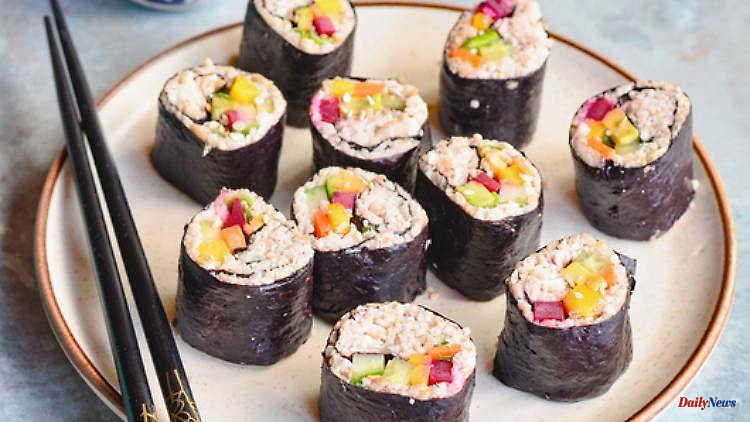Most people think of raw vegetables when they think of raw food, but those who are not vegan can also eat fish, meat, eggs, milk and cheese. It must not have been heated, more precisely: not over 42 degrees. Raw food nutrition is said to help with many health problems and strengthen the immune system.
Fresh, unprocessed foods - this is what a raw food diet is made up of. At least that's how Petra Bracht, specialist in general and nutritional medicine in Bad Homburg, defines it. The only rule: To keep the food fresh, it should not be heated above 42 degrees. So the stove stays cold, instead the food processor, blender and maybe a dehydrator are the most important appliances.
All vegetables, or what? That doesn't necessarily apply to raw food. There are vegan or vegetarian variants. However, a raw food diet can also mean eating raw fish, raw meat and raw eggs, and sometimes raw milk and raw milk cheese.
How raw food is ultimately implemented can look very different, says Petra Bracht, who is the author of several nutritional guides. Also on the plate at the end: From spaghetti made from zucchini and carrots to no-bake brownies made from dates and nuts - the raw food cuisine invites you to get creative.
It's the same with Melanie and Sönke Brummerloh. They eat more than half of their food raw. "Although it's always about healthy food for us, the taste is actually the top priority," the two write on their full-value blog.
Even if the stove usually stays cold, the Brummerlohs grate vegetables with the two children, grind grain or puree fruit. Experimenting with recipes and ingredients has become both a passion and a profession for the two medically certified health advisors.
Initially, however, the switch to a predominantly plant-based and raw food diet was due to health reasons. While Melanie Brummerloh suffered from joint pain, Sönke Brummerloh had struggled with neurodermatitis, hay fever and allergies since childhood.
The couple decided to switch up their diet and quickly noticed changes. Not only did Melanie's joint pain disappear - Sönke was suddenly able to eat strawberries and hazelnuts again without allergic reactions. And in summer you can walk across meadows without hay fever.
"Wholefood raw food can help very quickly," confirms nutritionist Petra Bracht. As soon as you change your diet, the microbiome, i.e. the intestinal flora, also changes. This in turn has a direct effect on the immune system, explains Bracht.
A raw food diet can also help normalize unhealthy blood lipid levels. In her practice, the doctor has observed rapid improvement after a change in diet for many typical civilization diseases such as high blood pressure, diabetes, allergies, pain or cardiovascular diseases.
However, the nutritionist does not advocate pure raw food. Eating only fruits, vegetables and herbs can lead to a protein deficiency. If your diet is too one-sided, you may also lose a lot of weight. And: It can happen that menstruation does not occur. In addition, according to Petra Bracht, the whole thing must still be "livable": "50 to 70 percent raw food is optimal."
The bloggers and cookbook authors Melanie and Sönke Brummerloh have also experienced that it is a challenge to reconcile the change in diet with family and friends. "If you knock everything over at once, it creates a rebellion," says Sönke Brummerloh jokingly.
So if you want to incorporate more raw food meals into your everyday life, it is best to start with small steps. A salad as a side dish, a breakfast of freshly ground grain and fruit, a homemade energy ball made from dates as a snack.
Step by step - this is also advised by nutritionist Petra Bracht. She has been eating at least 50 percent raw food for around 30 years. "It's best to give yourself a quarter of a year to get used to it," she says. "Especially the first eight days can be bumpy, but after that you should feel positive changes soon."
By the way: Thorough chewing is particularly important with raw food. This is good preparation for digestion. To counteract nutrient deficiencies, Bracht recommends taking vitamin B12 and a multivitamin product regularly.
In addition to motivation and background knowledge, good equipment is what counts in everyday life if you want to get into raw food cooking. According to the Brummerlohs, this includes a good knife, a cutting board and a sturdy blender.
And otherwise: openness to the raw food variety. Because in addition to the classic fruit and vegetables, wild herbs, green leaves, root vegetables, seeds, sprouts and nuts also provide a lot of variety at the Brummerlohs. One vegetable that both of them are particularly fond of is cauliflower. Because it can not only be mixed into salads or smoothies, but is also ideal for vegan cauliflower sushi.












